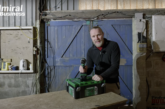Roger Bisby has a shave with the Triton Triple blade planer.
It isn’t every carpenter that needs a triple blade planer and this one from Triton is certainly not going to be your go-to tool for shooting in a door. It is a huge, very powerful 1,500 watt machine, equal to many bench planers, but rather than taking the work to the planer you can take the planer to the work. The blade width is 170mm, so you can achieve good coverage in fewer sweeps. The blade depth can be adjusted from zero to 2mm. This means you can use it for stock removal as a beam planer or for bringing down glued up table tops and worktops. The blade width is enough to give you a perfectly flat surface, but introducing it to the surface and holding it level at the end is something that takes a little practice. What I am saying is don’t let it loose on your lovely bit of hardwood until you get used to it. Practice on something you are going to chuck away.
![]()
The front handle is adjustable but the rear handle sits right at the back and is low. I think the idea is that you can keep the back down and, therefore, the front won’t dip as it comes off the edge at the end of the sweep.
In the past I have tended to use a single blade planer simply because you don’t have to worry about balancing the blades, but with three blades you have no choice. It is set up out of the box but when you change the blades you need to change all three – and make sure they are set properly. This is not as daunting as it could be because the shoulder of the blade sits on the holder, and you can run a straight edge and a torch to make sure it lines up. Once you are sure you have them correctly positioned you can torque up the screws on the clamps, but you have to do them up in a specific order.
There is a back rest that drops down to keep the blade off the workpiece, which is slightly annoying because it drops down if you lift the back up, and you have to run the plane in from the beginning to get it to sit down. The old machine didn’t have a back rest and you needed to keep a scrap of wood handy to rest it on. In some ways I preferred that because this little bit of plastic dropping down is a bit of an unknown because, unlike a rear flap, you can’t see it.








